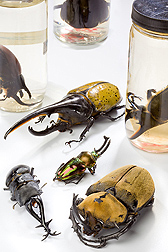This page has been archived and is being provided for reference purposes only. The page is no longer being updated, and therefore, links on the page may be invalid.
Read the magazine story to find out more. |
|
|
ARS Scientists Use Invertebrate Collections to Help Solve Agricultural Problems
By Alfredo FloresJanuary 15, 2010
Creepy, crawly spiders and bugs are just some of the unusual creatures in the Agricultural Research Service (ARS) invertebrate collections. While many find insects a nuisance, ARS scientists rely on these collections to study insect species and to find ways to protect U.S. crops and people from them.
The accessions in the collections come from all over the world. Among the most impressive are the rhinoceros, hercules, and king stag beetles—some 6 inches in length—at the National Museum of Natural History in Washington, D.C. These are among the 35 million insect and mite specimens in the museum’s National Entomological Collection.
When U.S. customs officials want to know more about a foreign insect found in a suspicious package, they can turn to the collection and ARS researchers to investigate the invertebrate’s biology, taxonomy, distribution and origin. Such collaborative efforts can help prevent the spread of exotic pests.
During the 2003-2004 growing season, the Aphid Biotype and Natural Enemy Collection—home to more than 100,000 specimens located in Stillwater, Okla.—was used to help solve the Russian wheat aphid outbreak in Colorado. Specimens in the collection allowed scientists to quickly determine that the biotype was not a new introduction to the country, and helped them understand pest resistance differences and come up with solutions to control the pest.
Just as important as the size and uses of the collections are the techniques used to preserve them. At the ARS Insect Genetics and Biochemistry Research Unit in Fargo, N.D., cryopreservation and cold storage technologies are vital in long-term preservation of insect germplasm, including that of the devastating screwworm livestock parasite.
Read more about how the invertebrate collections help solve agricultural problems in the January 2010 issue of Agricultural Research magazine, available online.
ARS is the principal intramural scientific research agency of the U.S. Department of Agriculture. This research supports the USDA priority of promoting international food security.

